Research led by scientists from the Medical Research Council Lifecourse Epidemiology Unit (MRC LEU) at the University of Southampton has shown that a higher income and being married reduces the risk of experiencing a broken bone in old age.
The study, published in Osteoporosis International, investigated whether differences in socioeconomic status, represented by income and marital status, were associated with fracture risk.
Researchers from the University of Southampton, University of Oxford, University of Bristol as well as Aalborg and Southern Denmark, analysed data from 189, 838 patients who had broken bones, compared with 189,838 patients who had not experienced a broken bone, drawn from the Danish population.
The team concluded that higher income was linked to the reduced chances of experiencing a fracture of the hip, upper arm or wrist compared with average income, and that those who were married had under half the likelihood of sustaining a fracture compared with those who were single.
Professor Nicholas Harvey, Professor of Rheumatology and Clinical Epidemiology at the MRC LEU, University of Southampton, who led the study, commented: “There are over 500,000 broken bones due to osteoporosis (thinning of the bones) annually in the UK at a cost of £4.4 billion and with an immense impact on health and survival.
“Given that we are in a period of increasing social inequality, our findings of differences in fracture risk by income and marital status provide further impetus for the need to ensure adequate provision of healthcare across all social strata, and to address the factors underlying these disparities.
“We don’t know for certain how being married protects against fracture, but studies show that marriage is protective against a range of adverse health outcomes, possibly through a various factors related to physical and mental health, security and economic status.”
Source: Read Full Article





